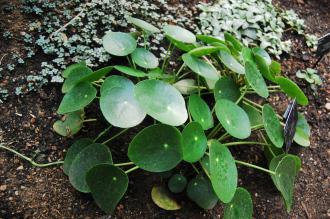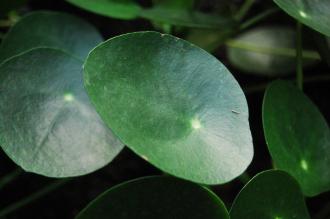
Pilea peperomioides (16/01/2016, Kew Gardens, London)
Position: Indirect bright to partial shade
Flowering period: Late spring
Soil: Moist, well drained
Eventual Height: 30cm
Eventual Spread: 30cm
Hardiness: 10b, 11, 12, 13
Family: Urticaceae
Pilea peperomioides is a succulent evergreen perennial with a clump forming habit. Its mid green leathery leaves are circular with entire margins, up to 10cm across and appear on a 10cm petiole which emerges from a central stem. Its white green flowers emerge on pinkish stems.
Pilea peperomioides, commonly known as Chinese Money Plant, Pancake Plant or Missionary Plant, is native to south China.
The etymological root of the binomial name Pilea is derived from the Latin pileus menaing ‘cap’. Peperomioides is derived from Latin meaning ‘like’ the genus Peperomia.
The landscape architect may find Pilea peperomioides useful as an foliage houseplant with interesting leaves and suitable for bright conditions.
Ecologically, Pilea peperomioides is of little value to UK wildlife.

Pilea peperomioides Leaf (16/01/2016, Kew Gardens, London)
The Royal Horticultural Society have given Pilea peperomioides their prestigious Award of Garden Merit in 1993.
Pilea peperomioides prefers moist, fertile, well-drained soils. It tolerates most pH of soil.
When maintaining Pilea peperomioides as a houseplant its soil should be watered regularly. Watering should be reduced during the winter months. Its preferred active growing temperature rages of between 10ºc to 24ºc. Feeding with weak fertiliser solution should be carried out every two weeks during the growing season. Powdery mildews may infect this plant.

Landscape Architecture

